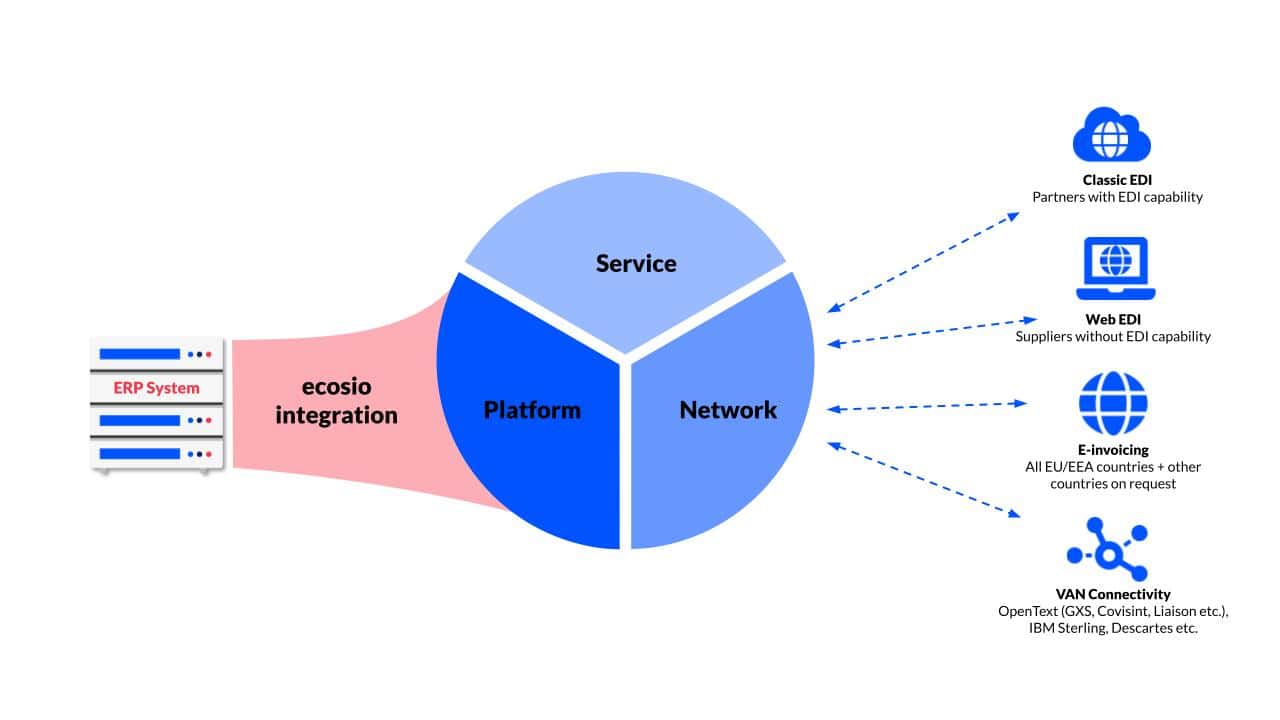When exchanging crucial business information with partners, having processes that are both accurate and efficient is essential. In order to minimise human error, maximise automation and increase speed, more and more businesses are utilising electronic data interchange (EDI) and application programming interfaces (APIs). But which will ultimately win the battle of EDI vs API and how can both be used to optimise B2B communication?
Before we answer these questions, let’s first explore how EDI and APIs work and the pros and cons of each.
How EDI works
EDI itself isn’t really a technology; it’s more like a method of B2B communication. In a nutshell, EDI is the means by which business partners exchange structured information such as orders, invoices and delivery notes with one another.
Sending an EDI message involves condensing the relevant data that one wishes to send into a specific computer-readable file format. This simple file is then transmitted to the recipient via an agreed transfer protocol, after which the recipient’s system then automatically reads, extracts and stores the data.
For a more detailed breakdown of how EDI works, please see our “What is EDI?” article.
The benefits of EDI
- Security. EDI is conduced using closed networks such as X.400 or VANs or by using dedicated point to point connections – e.g. based on AS2, SFTP or OFTP2. The security credential exchange with the business partner is usually done via a secure channel – e.g. in case of ecosio using the ecosio.monitor. Plain APIs are often secured with HTTP Basic Authentication or Bearer Tokens, whereby the exchange of the security credentials is not clearly defined. More modern approaches such as OAuth2, however, are successfully trying to overcome this limitation, by introducing a central identity provider.
- Popularity. As it has been around for decades, EDI is used by businesses worldwide and across all industries. Today it is by far the most popular method of exchanging business-critical information with partners and is thus the logical choice for those debating EDI vs API.
- Time-saving. By vastly reducing the number of manual tasks involved in sending/receiving B2B documentation, EDI allows internal teams to focus on more value-adding tasks while simultaneously reducing the potential for human errors.
- Low message size. Compared to other methods of exchanging data, such as via email or JSON, sending messages via EDI standards (with the exception of XML) requires much less bandwidth..
The limitations of EDI
- Batch processing. In most EDI scenarios messages are sent and received in batches (e.g. once a day) rather than one at a time. While this may not be a big issue for some, it does prevent real-time data visibility. This in turn impacts the ability of businesses to respond quickly to new information – e.g. by updating inventory levels.
- Partner-specific communication channels. Though EDI can be used by companies to connect them with thousands of partners, each partner connection must be set up individually. For customers, this typically involves providing suppliers with a message implementation guide (MIG) which specifies the desired file format and transfer protocol. The supplier then needs to conduct technical mapping to ensure information can be correctly converted from their inhouse format to the required EDI format. Once this is done, they must then send test messages via the agreed protocol before the connection is made live.
- Limited traceability. In traditional EDI exchanges, it generally isn’t possible to see whether or not a message has been received by the final recipient. Even when modern protocols such as AS4 are used, the sender can typically only see when a message reaches the EDI service provider (a bit like seeing just one grey tick on WhatsApp and not two blue ticks).
What is REST API?
REST stands for Representational State Transfer. REST itself isn’t a protocol. It’s a widely employed method of writing APIs. APIs inherently lack a standardised composition. Instead, their structure is dependent on messaging formats such as JSON, with REST relying on HTTP(S).
The benefits of APIs
- Speed. With APIs there’s no need to wait for the other side to send information; instead relevant data can be pulled automatically as soon as it becomes available. In fast moving supply chains this can be extremely useful.
- Flexibility. APIs are by their nature flexible, as there are few rules and standards concerning how data must be used. This makes APIs a fantastic tool for software developers as they can be integrated into existing and emerging solutions to boost performance, whether this involves pulling relevant data periodically or receiving data instantly via POST.
- Simplicity. Unlike with EDI, with APIs there’s no need for data to be transformed to and from different encrypted formats. Instead, the API connects systems (e.g. ERP systems) directly, meaning data is automatically updated in the relevant place.
- Less specialised. As APIs are used in a myriad of different scenarios, knowledge of how to use APIs is not limited to individuals with experience in certain industries – something that cannot be said for EDI expertise. All web developers should have at least a basic understanding of how to use APIs.
The limitations of APIs
- Scalability. As every business’s data is structured and stored differently, no two APIs are the same. As a result, unlike with EDI, where mappings between common EDI file formats and your inhouse format can be reused as the semantics of the data being exchanged is standardised, every API-based connection requires a bespoke technical setup. Similarly, there is also no standardised way of designing APIs, meaning there is no agreed process choreography. For example, whereas one partner might request a purchase order response, another may simply take a successful order placement as confirmation – a situation that can easily lead to issues.
- Popularity. When it comes to the EDI vs API debate concerning B2B interactions, this is a key issue. Thanks largely to the lack of scalability offered by APIs, the vast majority of supply chain organisations prefer to exchange information via EDI, with many larger customers simply refusing to work with suppliers who cannot conduct EDI.
- Security. While an API may be extremely useful in some cases – e.g. allowing all potential partners to see your full product catalogue master data – it isn’t suitable for exchanging sensitive information.
- Missing information. APIs typically don’t include information such as logical sender address, receiver address or document type definitions. Although these aren’t required in point-to-point scenarios, they are extremely important when communicating with the third-party-networks used by large businesses.
- Internet-dependent. As APIs depend on a stable internet connection, if and when you experience internet connectivity issues, it will not be possible to retrieve information via API.
Why APIs won’t replace EDI
Having examined the benefits of APIs, one could be forgiven for concluding that APIs will replace EDI as the main method by which B2B partners exchange information. Undoubtedly, APIs do offer considerable advantages when it comes to streamlining B2B interactions. In particular, EDI cannot compete with the speed with which APIs allow information to be fetched, the depth of integration API’s offer into existing systems, or the data visibility APIs provide.
However, there is one key reason why APIs will never ultimately win the EDI vs API battle… the need for bespoke processes.
Until such a time as universally acknowledged rules are created for APIs and their usage in supply chains, all API integrations will involve unique technical requirements and must therefore be handled individually. Although APIs may be great for a single point-to-point connection between two partners, it is simply not possible to use the same approach for a wide partner landscape. Imagine a supplier with hundreds of customers, for example. If APIs were used for each connection, potentially every customer could demand that the supplier follows a different process. This would involve a huge amount of time and effort.
By contrast, EDI usage has continued to grow over the decades as its insistence on the use of accepted file formats and standardised processes enables connections to be established much faster and for previous mapping work to be reused. Similarly, EDI’s methodology and focus on standardisation also ensures the right data is exchanged and makes it easy to test multiple different business scenarios, in turn helping to avoid issues further down the line.
Why the future is EDI + API, not EDI vs API
While APIs will never replace EDI for the reasons explained above, this doesn’t mean that APIs can’t help to boost the efficiency of B2B communication. In fact, used properly, APIs can transform EDI solutions by providing functionalities previously out of reach to EDI users.
For example, two of EDIs major limitations – namely its limited data visibility and reliance on batch processing – can be essentially eliminated by incorporating APIs. While converting internal data into agreed formats and transmitting this data to partners via secure protocols still offers the most efficient solution for exchanging critical B2B information, APIs can streamline the process at either end by allowing relevant systems to talk to one another. By incorporating APIs into EDI processes, users can experience end-to-end message visibility, allowing them to see whether or not partners have received or acknowledged a message in real time. Meanwhile, by integrating an EDI solution into your ERP system via API, EDI data can be made accessible to any and all relevant individuals within your existing user interface, ensuring that EDI doesn’t become a black box.
Similarly, the rapid rise of country-specific e-invoicing requirements presents another arena where APIs can improve the efficiency of EDI solutions, with API usage even mandated by public administrations in some countries.
In conclusion, although there is certainly some overlap in what API and EDI do, they each have their own separate domains. It’s therefore pointless to picture the situation as EDI vs API. They aren’t enemies, but rather tools that can be combined intelligently to create flexible yet secure B2B integration solutions.
How ecosio EDI solution works
At ecosio we’re acutely aware of the benefits of combining EDI expertise with a powerful API and have developed a unique solution incorporating API to help our clients achieve maximum automation with minimum effort.
As illustrated below, the technical hub of ecosio EDI solution is called the Integration Hub. This is located in the cloud, and is where all the technical mapping and routing work is done by ecosio’s EDI experts to connect you to your partners. Crucially, rather than requiring clients to send data to the Integration Hub manually, ecosio EDI solution is integrated directly into clients’ ERP systems.
This deep integration enables you to benefit from unmatched data visibility and real-time monitoring within your existing user interface. The result? No need for additional systems, no more frustrating bottlenecks, and no more silent message failures.
What’s more, thanks to ecosio’s ongoing message monitoring, when errors do occur, they are identified and resolved proactively by our EDI experts, leaving your team free to focus on more value-adding activities.
Discover more about our updated product, ecosio.flow.













